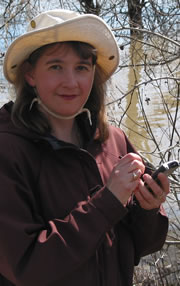Fescue findings
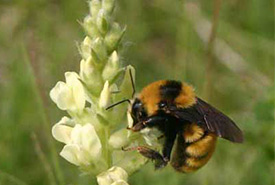
A bumblebee on field locoweed. (Photo by Diana Bizecki Robson)
As I near the end of my two years of pollinator research in the fescue prairie, I’ve been wondering what it all means. In particular I’ve been thinking about how the pollinator communities in fescue prairies are different than in the tall grass prairies. Here are the patterns that seem to be emerging:
1. Bees are more important pollinators in fescue prairie than flies.
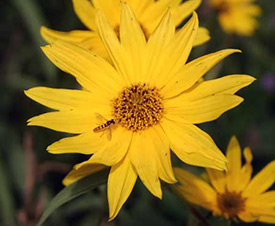
Syrphid flies prefer regular flowers like this sunflower. (Photo by Diana Bizecki Robson)
When most people think of pollinators they usually think of bees and butterflies. One of the things I discovered is that flies seem to be more common pollinators than bees in the tall grass prairie and the reverse true in the fescue prairie. Why is this so? I suspect that it is because tall grass prairies are in general moister than most other habitats.
Many bee species nest underground and if the soil is saturated with water they may not be able to breed successfully. Flies on the other hand breed in a wider variety of habitats (many even have parasitic larvae) and are less affected by moist soils. In fact, fly species that breed in water would benefit from moist conditions.
2. The dominant pollinators may affect plant community composition.
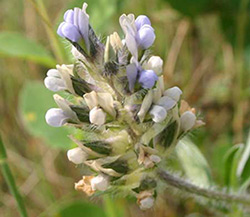
The irregular flowers of this breadroot plant are attractive to bees. (Photo by Diana Bizecki Robson)
Irregular flowers were more abundant on the fescue prairie, comprising about a third of all insect-pollinated plant species. Further, a greater percentage of visits (about 27 percent) were to the irregular flowers (i.e. flowers whose halves are mirror images of each other like snapdragons) on the fescue prairie. In tall grass prairie, irregularly flowered plants comprise only about a quarter of all species and receive less than three percent of all insect visits.
Irregular flowers, particularly those with long floral tubes, are attractive to long-tongued bees and butterflies. Regular flowers with short or no floral tubes are preferred by small bees and flies, which typically (although not always) have shorter tongues. Thus the pollinator community appears to be influencing the composition of the plant community by preferentially fertilizing irregular flowers.
3. Insect activity was lower in the spring on fescue prairies than on tall grass prairie.
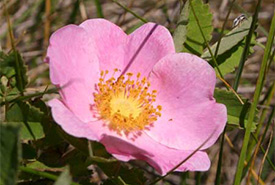
This prickly rose is visited by flies and small bees. (Photo by Dr. Diana Bizecki Robson)
Bees were more abundant pollinators in the fescue prairie than flies. However in the spring their populations are still small as only the queen bees are out foraging. Bee populations reach their peak in late summer when worker bees are busy collecting nectar and pollen. In contrast, pollinator visits were much higher in the tall grass prairie in spring due to large populations of overwintering flies that hatched once it warmed up.
4. Grazing can alter pollinator activity.
When comparing the visitation rate between grazed and ungrazed plots over the whole year, there was no difference except with respect to timing. The grazed fescue prairie plots had more flowers in spring and early summer and subsequently more insect visitation at those times. Ungrazed plots produced more flowers in late summer and fall, and experienced more visitations at this time of the year. This suggests that the ideal land management is a combination of grazing and rest so that a maximum diversity of flowers are available to the pollinator community over the year.
This post originally appeared on the Botany blog of the Manitoba Museum.

